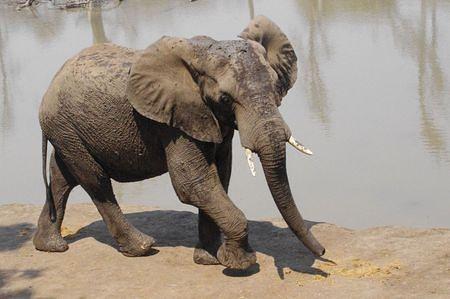The African elephant is the biggest living land animal on earth.
Elephants are well-known for their memory, intelligence, unique ways of
communication and incredible social behaviour with each other, and even with
other wildlife species and humans.

The African elephant has much larger tusks, ears and a more pronounced
sloping forehead than the Asian elephant. At the end of its trunk, the
African elephant has two fingers compared to the Asian elephant's one
An elephant’s trunk is nearly as able as the human hand, yet much stronger.
They use the trunk to smell, drink water and for communication.
Elephant tusks are in fact long curved incisor teeth, that continue to keep
growing all through the life of an elephant. The tusks of an elephant is
used as a multi-purpose tool by them, from breaking bark off trees, and also
as weapons of defence and sparring.
Elephants move and feed day and night, as they need to eat as much as 300 kg
of fodder in a day! Their diet include grass, bark, soft tree branches and
herbs. Mature elephants sleep while standing up, but in only short little
naps.
Elephants need a lot of water (about 140 litres), and will visit a waterhole
at least once a day to drink and cover themselves in mud, which help to
cool-down their huge bodies and to act as a kind of sunscreen for them.
Elephant herd consists of small family groups, which are led by a older
experience matriarch. Elephant bulls are generally solitary, or form
bachelor herds.
The famous desert elephants of the Namibian Kaokoland and Damaraland desert
regions, has changed their behaviour to only drinking water every second day
or so. These elephants are less active during the day, and also less
destructive of trees. Gateway Africa has various
wildlife safaris in Namibia, that cover the desert elephant ranges.
